Plan and Then Act: The Moderated Moderation Effects of Profession Identity and Action Control for Students at Arts Universities during the Career Development Process
Abstract
1. Introduction
2. Materials and Methods
2.1. Study Design
2.2. Participants, Recruitment, and Data Collection
2.3. Instrument Validity and Administration
- FTP
- 2.
- Grit
- 3.
- CDSE
- 4.
- Burnout
- 5.
- Career Hope
- 6.
- Profession Identity
- 7.
- Action Control
2.4. Data Analysis
3. Results and Discussion
3.1. Descriptive Statistics and Validity of Variables
3.2. Path Model and Test of Mediation Effect
3.3. Test of Moderation Effect
3.4. Test of Moderated Moderation Effect
4. Conclusions and Implications
- FTP and grit among preservice teachers did not have a direct effect on their burnout and career hope; the effect was mediated by CDSE. Preservice teachers with higher CDSE had less burnout and higher career hope. This result showcases that career decision-making effectiveness (CDSE) is the key psychological mechanism that affects preservice teachers’ learning burnout and career hope. Either FTP or grit exercises its effect through CDSE. Teacher training institutions should strengthen preservice teachers’ sense of efficacy in making career decisions.
- Profession identity moderated the relationship between FTP and CDSE; FTP and CDSE had a significant ordinal interaction. Teacher identity increased the effect of FTP on CDSE. In other words, preservice teachers with a teacher identity and higher FTP had higher CDSE, whereas those with a teacher identity and lower FTP had lower CDSE. Although choosing to study in a teacher education program does not mean that they must be teachers in the future, we found that if preservice teachers could not decide whether they wanted to be teachers in the future, they would display a non-adaptive learning pattern. Therefore, we believe that career exploration is an urgent task for preservice teachers.
- In terms of MoMo, a moderated moderation effect of action control was observed. The CDSE of preservice teachers was more strongly moderated by their profession identity if they were more inclined toward action control. Preservice teachers with action control, higher CDSE, and a teacher identity had the least amount of burnout. This finding suggests that both profession identity and action control play a key role, as action control can effectively reduce burnout among preservice teachers regardless of their profession identity. Although preservice teachers at arts universities have less time resources and more pressure than those at general universities, if they can be taught strategies to take practical action, they can effectively reduce their burnout, resembling the well-known slogan of the famous sports brand Nike—“Just do it”— which is also why this study is entitled “Plan and Then Act”.
Author Contributions
Funding
Institutional Review Board Statement
Informed Consent Statement
Data Availability Statement
Acknowledgments
Conflicts of Interest
References
- Liu, M.-C.; Chiu, J.-R.; Hu, J.-L. Rising Employability in Formal Education; National Youth Commission, Executive Yuan: Taipei, Taiwan, 2006. [Google Scholar]
- Gjesme, T. On the concept of future time orientation: Considerations of some functions’ and measurements’ implications. Int. J. Psychol. 1983, 18, 443–461. [Google Scholar] [CrossRef]
- Chen, C.C.; Hung, C.H. Interest or self-efficacy: Which came first? Examination on the interest model of social cognitive career development theory-the case for a University of Arts. J. Educ. Psychol. 2021, 44, 1–33. [Google Scholar] [CrossRef]
- Husman, J.; Lens, J. The role of the future in student motivation. Educ. Psychol. 1999, 34, 113–125. [Google Scholar] [CrossRef]
- Nowack, K.; Milfont, T.L.; van der Meer, E. Future versus present: Time perspective and pupillary response in a relatedness judgment task investigating temporal event knowledge. Int. J. Psychophysiol. 2013, 87, 173–182. [Google Scholar] [CrossRef]
- Burns, M.J.; Dillon, F.R. AIDS health locus of control, self-efficacy for safer sexual practices, and future time orientation as predictors of condom use in African American college students. J. Black Psychol. 2005, 31, 172–188. [Google Scholar] [CrossRef]
- Peng, M.Y.P. Future time orientation and learning engagement through the lens of self-determination theory for freshman: Evidence from cross-lagged analysis. Front. Psychol. 2022, 5246. [Google Scholar] [CrossRef]
- Horstmanshof, L.; Zimitat, C. Future time orientation predicts academic engagement among first-year university students. Br. J. Educ. Psychol. 2007, 77, 703–718. [Google Scholar] [CrossRef]
- Jung, H.; Park, I.J.; Rie, J. Future time perspective and career decisions: The moderating effects of affect spin. J. Vocat. Behav. 2015, 89, 46–55. [Google Scholar] [CrossRef]
- Duckworth, A.L.; Kirby, T.A.; Tsukayama, E.; Berstein, H.; Ericsson, K.A. Deliberate practice spells success: Why grittier competitors triumph at the National Spelling Bee. Soc. Psychol. Personal. Sci. 2011, 2, 174–181. [Google Scholar] [CrossRef]
- Kelly, D.R.; Matthews, M.D.; Bartone, P.T. Grit and hardiness as predictors of performance among West Point cadets. Mil. Psychol. 2014, 26, 327–342. [Google Scholar] [CrossRef]
- Ray, P.A.; Brown, C.M. Confronting Climate Uncertainty in Water Resources Planning and Project Design: The Decision Tree Framework. World Bank Publications: Washington, DC, USA, 2015.
- Ray, R.; Brown, J. Reassessing student potential for medical school success: Distance traveled, grit, and hardiness. Mil. Med. 2015, 180, 138–141. [Google Scholar] [CrossRef]
- Eskreis-Winkler, L.; Shulman, E.P.; Beal, S.A.; Duckworth, A.L. The grit effect: Predicting retention in the military, the workplace, school and marriage. Front. Psychol. 2014, 5, 36. [Google Scholar] [CrossRef]
- Robertson-Kraft, C.; Duckworth, A.L. True grit: Trait-level perseverance and passion for long-term goals predicts effectiveness and retention among novice teachers. Teach. Coll. Record. 2014, 116, 1–27. [Google Scholar] [CrossRef]
- Seguin, C. A survey of nurse leaders to explore the relationship between grit and measures of success and well-being. JONA 2019, 49, 125–131. [Google Scholar] [CrossRef] [PubMed]
- Videla, R.; Aguayo, C.; Veloz, T. From STEM to STEAM: An enactive and ecological continuum. Front. Educ. 2021, 6, 709560. [Google Scholar] [CrossRef]
- Lent, R.W.; Brown, S.D.; Hackett, G. Toward a unifying social cognitive theory of career and academic interest, choice, and performance. J. Vocat. Behav. 1994, 45, 79–122. [Google Scholar] [CrossRef]
- Xu, P.; Peng, M.Y.P.; Anser, M.K. Effective learning support towards sustainable student learning and well-being influenced by global pandemic of COVID-19: A comparison between mainland china and Taiwanese students. Front. Psychol. 2021, 12, 561289. [Google Scholar] [CrossRef]
- Chen, C.C.; Hung, C.H. “Failing to plan” is “planning to fail”? The differences of career expansion model between teacher program students and non-teacher program students at an Arts University. J. Educ. Psychol. 2020, 43, 1–32. [Google Scholar] [CrossRef]
- Bandura, A. Social Foundations of Thought and Action: A Social Cognitive Theory; Prentice-Hall: Englewood Cliffs, NJ, USA, 1986. [Google Scholar]
- Kuhl, J. Volitional mediators of cognition-behavior consistency: Self-regulatory processes and action versus state orientation. In Action Control: From Cognition to Behavior; Kuhl, J., Beckmann, J., Eds.; Springer-Verlag: New York, NY, USA, 1985; pp. 101–128. [Google Scholar]
- Kuhl, J. Action control: The maintenance of motivational states. In Motivation, Intention and Volition; Halisch, F., Kuhl, J., Eds.; Academic Press: New York, NY, USA, 1987; pp. 279–291. [Google Scholar]
- Boström, E.; Palm, T. Expectancy-value theory as an explanatory theory for the effect of professional development programmes in formative assessment on teacher practice. Teach. Dev. 2020, 24, 539–558. [Google Scholar] [CrossRef]
- Richardson, P.W.; Watt, H.M.G. Why people choose teaching as a career. An expectancy-value approach to understanding teacher motivation. In Teacher Motivation. Theory and Practice; Richardson, P.W., Karabenick, S.A., Watt, H.M.G., Eds.; Routledge: New York, NY, USA, 2014; pp. 3–19. [Google Scholar]
- Bruinsma, M.; Jansen, E.P. Is the motivation to become a teacher related to pre-service teachers’ intentions to remain in the profession? Eur. J. Teach. Educ. 2010, 33, 185–200. [Google Scholar] [CrossRef]
- Watzke, J.L. Longitudinal research on beginning teacher development: Complexity as a challenge to concerns-based stage theory. Teach. Teach. Educ. 2007, 23, 106–122. [Google Scholar] [CrossRef]
- Duckworth, A.L.; Peterson, C.; Matthews, M.D.; Kelly, D.R. Grit: Perseverance and passion for long-term goals. J. Pers. Soc. Psychol. 2007, 92, 1087–1101. [Google Scholar] [CrossRef] [PubMed]
- Betz, N.E. Self-concept theory in career development and counseling. Career Dev. Q. 1994, 43, 32–42. [Google Scholar] [CrossRef]
- Hackett, G.; Betz, N.E. A self-efficacy approach to the career development of women. J. Vocat. Behav. 1981, 18, 326–339. [Google Scholar] [CrossRef]
- Lent, R.W.; Tracey, T.; Brown, S.D.; Soresi, S.; Nota, L. Development of interests and competency beliefs in Italian adolescents: An exploration of circumplex structure and bidirectional relationships. J. Couns. Psychol. 2006, 53, 181–191. [Google Scholar] [CrossRef]
- Turner, S.L.; Steward, J.C.; Lapan, R.T. Family factors associated with sixth-grade adolescents’ math and science career interests. Career Dev. Q. 2004, 53, 41–52. [Google Scholar] [CrossRef]
- Raedeke, T.D.; Smith, A.L. Development and preliminary validation of an athlete burnout measure. J. Sport Exerc. Psychol. 2001, 23, 281–306. [Google Scholar] [CrossRef]
- Gustafsson, H.; Martinent, G.; Isoard-Gautheur, S.; Hassmén, P.; Guillet-Descas, E. Performance based self-esteem and athlete-identity in athlete burnout: A person-centered approach. Psychol. Sport Exerc. 2018, 38, 56–60. [Google Scholar] [CrossRef]
- Snyder, C.R. Hope theory: Rainbows of the mind. Psychol. Inq. 2002, 13, 249–275. [Google Scholar] [CrossRef]
- Huang, H.-S.; Chen, H.-P.; Gan, M.-L. Development of a career hope scale for university student. J. Educ. Stud. 2014, 48, 23–43. [Google Scholar] [CrossRef]
- Lally, P.S.; Kerr, G.A. The career planning, athletic identity, and student role identity of intercollegiate student athletes. Res. Q. Exerc. Sport. 2005, 76, 275–285. [Google Scholar] [CrossRef] [PubMed]
- Wigfield, A.; Eccles, J.S. Expectancy–value theory of achievement motivation. Contemp. Educ. Psychol. 2000, 25, 68–81. [Google Scholar] [CrossRef] [PubMed]
- Chen, C.-C. The relationship of achievement goal, action control orientation and the mediating effect of perceived mathematical competence on learning behavior patterns of junior high school students. J. Educ. Psychol. 2002, 25, 629–656. [Google Scholar]
- Hayes, A.F. Introduction to Mediation, Moderation, and Conditional Process Analysis: A Regression-Based Approach; Guilford Publications: New York, NY, USA, 2017. [Google Scholar]
- Preacher, K.J.; Rucker, D.D.; Hayes, A.F. Addressing moderated mediation hypotheses: Theory, methods, and prescriptions. Multivar. Behav. Res. 2007, 42, 185–227. [Google Scholar] [CrossRef]
- Byrne, B.M. Structural Equation Modeling with AMOS: Basic Concepts, Applications, and Programming; Routledge: New York, NY, USA, 2009. [Google Scholar]
- Hu, L.T.; Bentler, P.M. Cutoff criteria for fit indexes in covariance structure analysis: Conventional criteria versus new alternatives. Struct. Equ. Model. 1999, 6, 1–55. [Google Scholar] [CrossRef]
- Fornell, C.; Larcker, D.F. Structural equation models with unobservable variables and measurement error: Algebra and statistics. J. Mark. Res. 1981, 18, 382–388. [Google Scholar] [CrossRef]
- Hair, J.F.; Black, W.C.; Babin, B.J.; Anderson, R.E. Multivariate Data Analysis, 8th ed.; Cengage: Boston, MA, USA, 2009. [Google Scholar]
- Chen, C.C.; Hsueh, J.H.; Chen, P.L. Turn left, turn right? The possibility of improving the performance of mathematics underachievers. J. Educ. Psychol. 2017, 40, 1–30. [Google Scholar] [CrossRef]
- Aiken, L.S.; West, S.G. Multiple Regression: Testing and Interpreting Interactions; Sage Publications: Newbury Park, CA, USA, 1991. [Google Scholar]

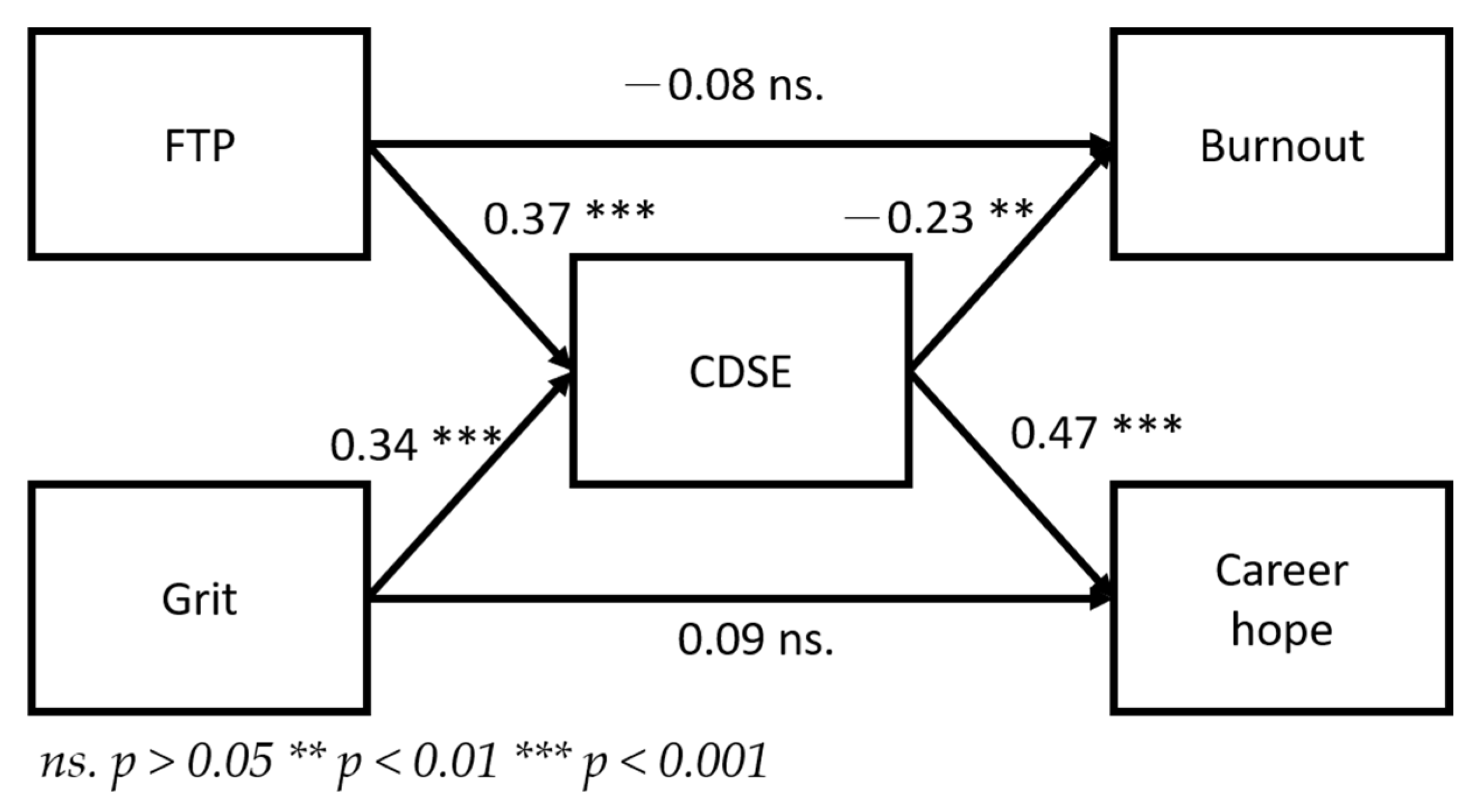
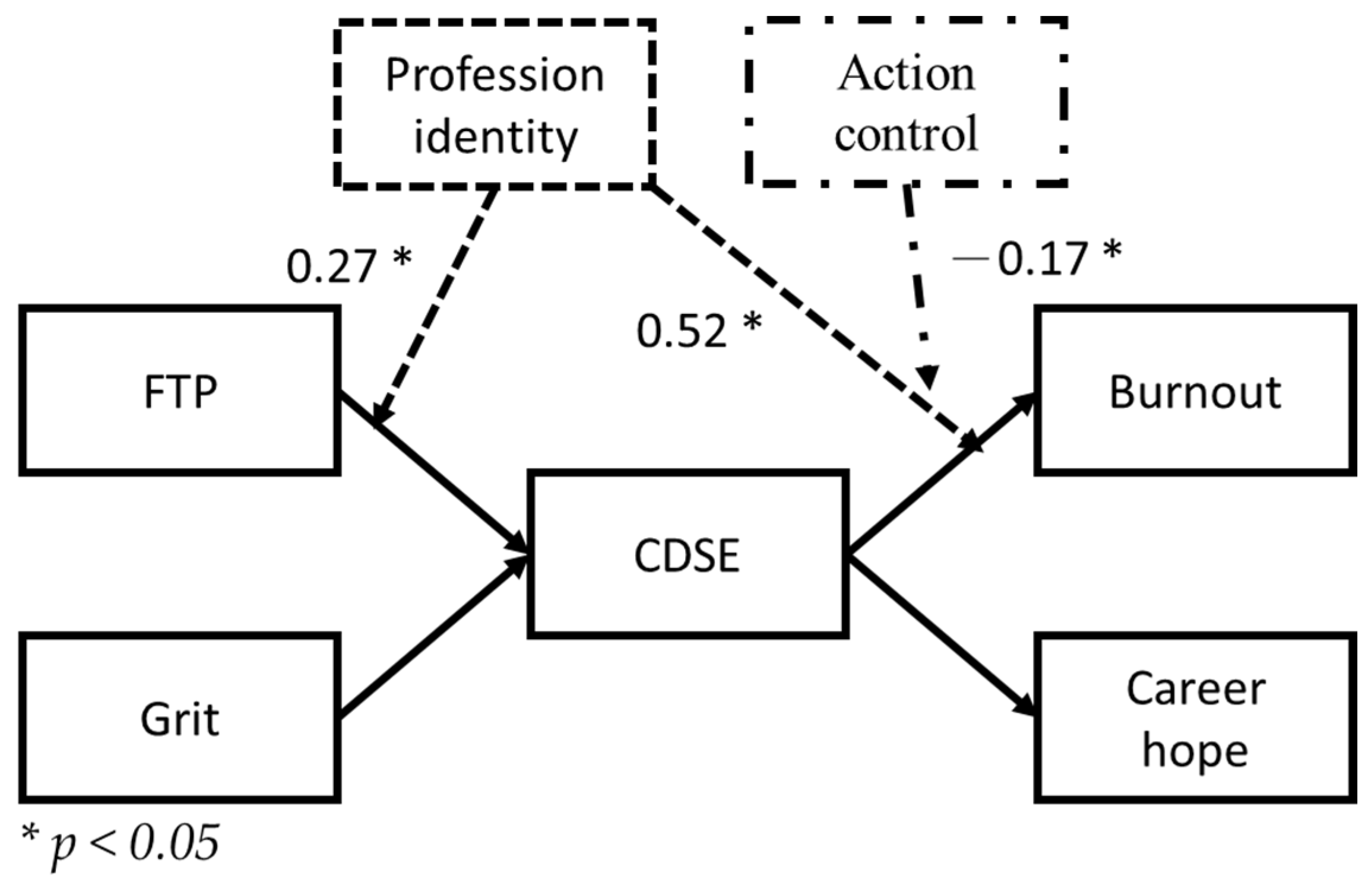
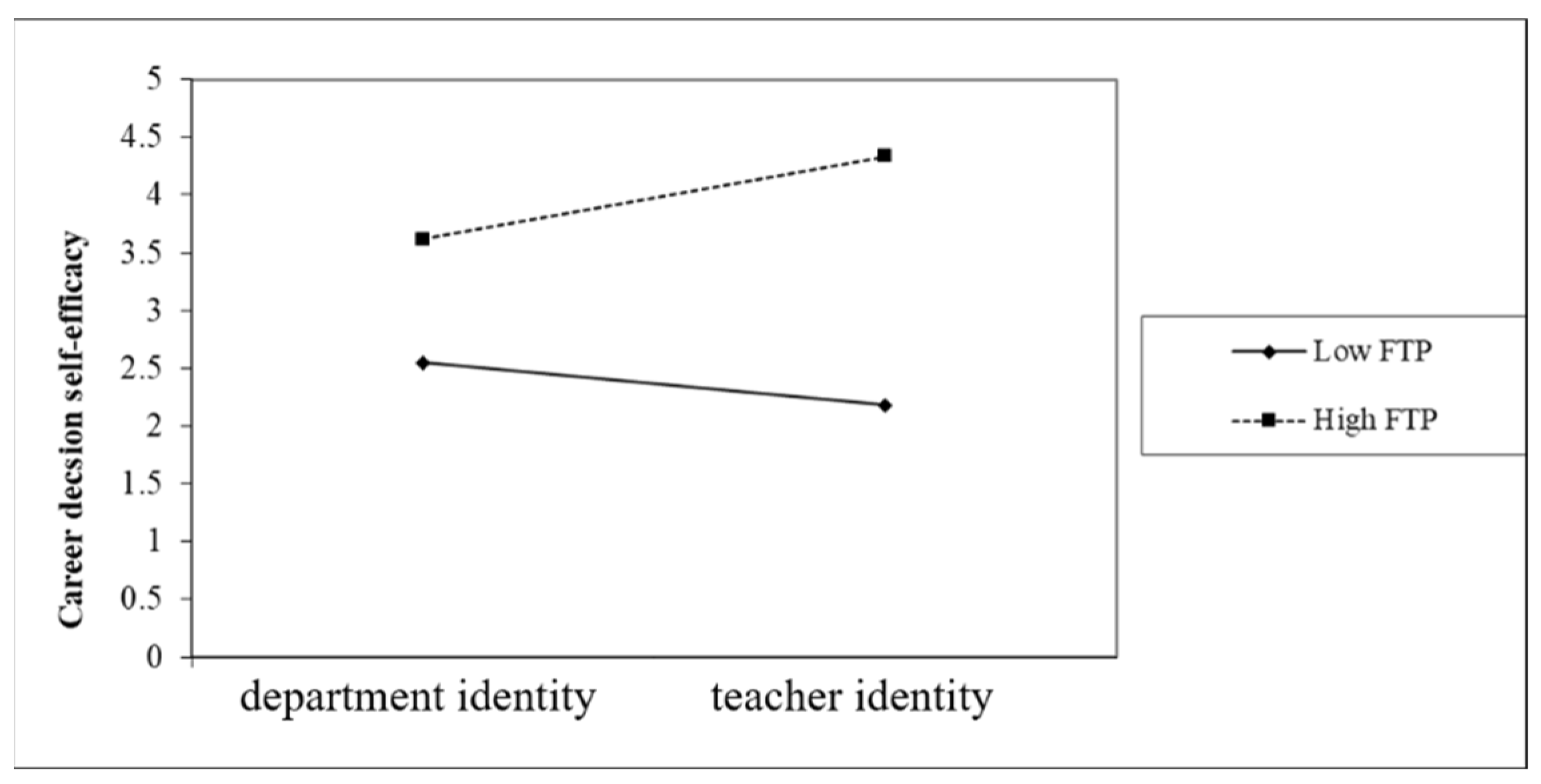
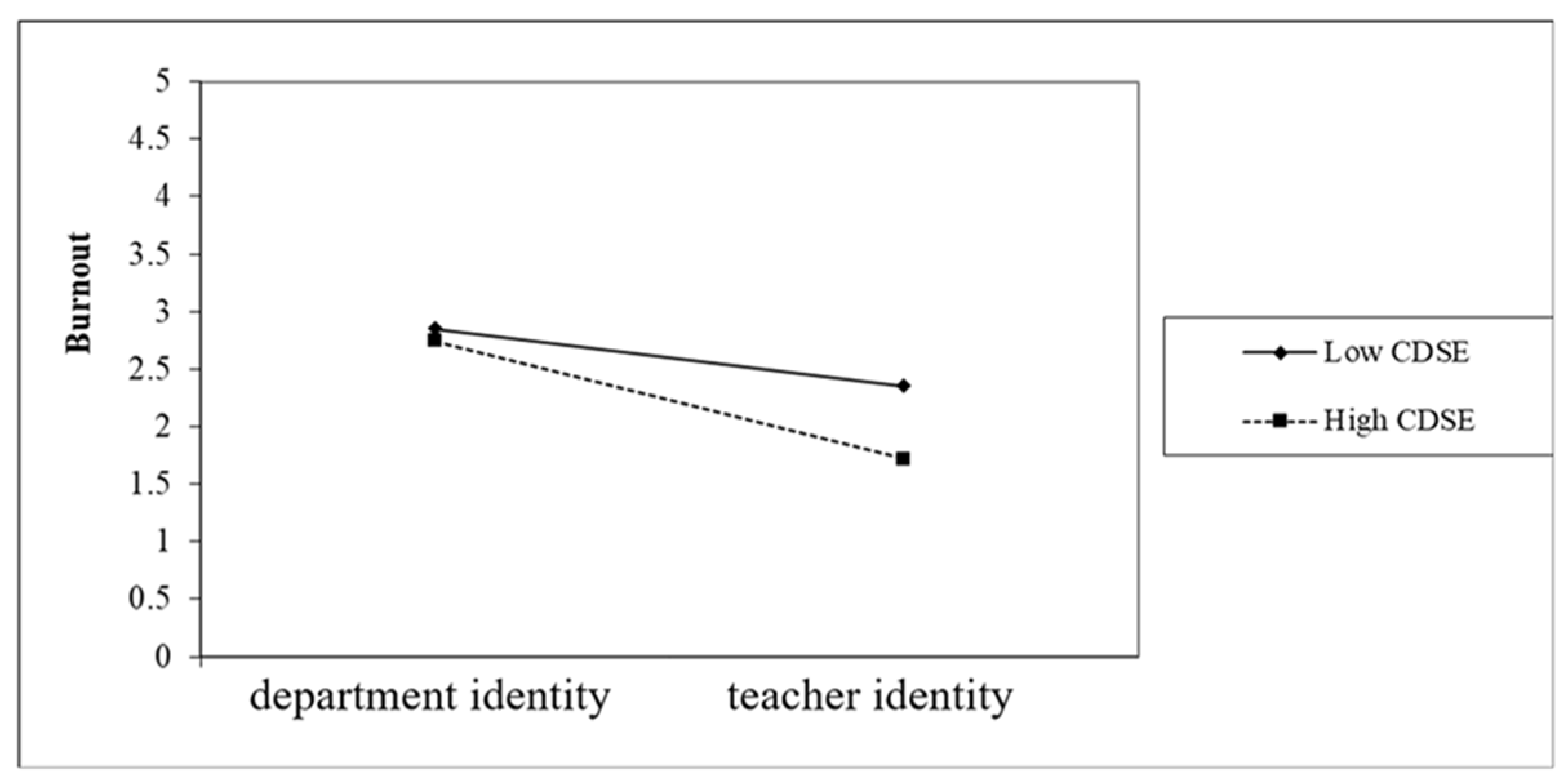
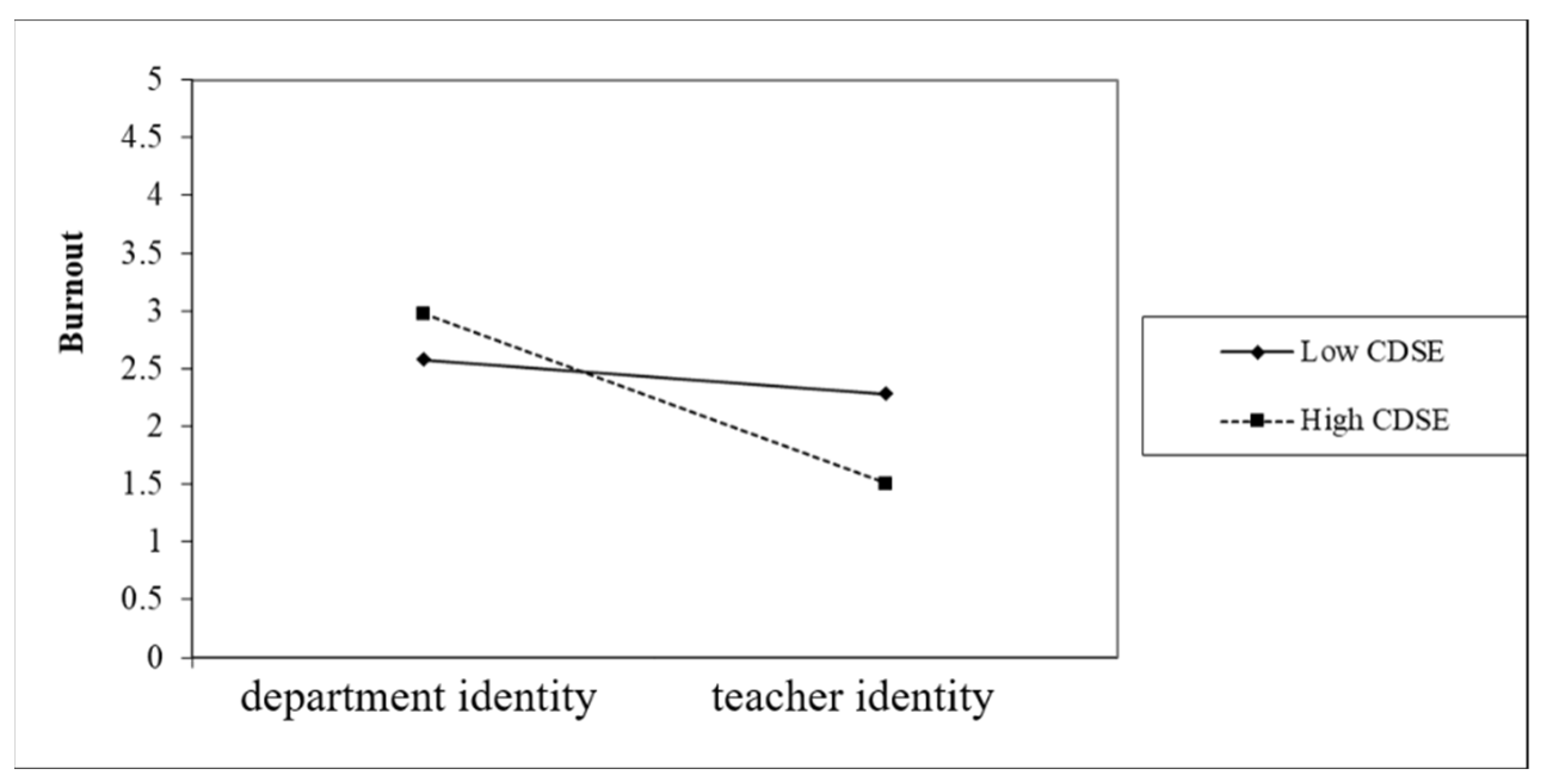

| Model | Hypothesis |
|---|---|
| Mediation | 1. CDSE mediates the FTP–burnout relationship. |
| 2. CDSE mediates the FTP–career hope relationship. | |
| 3. CDSE mediates the grit–burnout relationship. | |
| 4. CDSE mediates the grit–career hope relationship. | |
| Moderation | 5. Profession identity moderates the FTP–CDSE relationship. |
| 6. Profession identity moderates the grit–CDSE relationship. | |
| 7. Profession identity moderates the CDSE–burnout relationship. | |
| 8. Profession identity moderates the CDSE–career hope relationship. | |
| Moderated moderation | 9. Action control moderates the moderation of profession identity on the FTP–CDSE relationship. |
| 10. Action control moderates the moderation of profession identity on the grit–CDSE relationship. | |
| 11. Action control moderates the moderation of profession identity on the CDSE–burnout relationship. | |
| 12. Action control moderates the moderation of profession identity on the CDSE–career hope relationship. |
| Variables | Mean | SD | Skewness | 1 | 2 | 3 | 4 | 5 | 6 |
|---|---|---|---|---|---|---|---|---|---|
| 1. FTP | 3.62 | 0.41 | −0.98 | 1 | |||||
| 2. Girt | 3.58 | 0.39 | −0.85 | 0.78 | 1 | ||||
| 3. CDSE | 3.23 | 0.62 | −0.54 | 0.63 | 0.63 | 1 | |||
| 4. Burnout | 2.20 | 0.67 | 0.12 | −0.22 | −0.27 | −0.28 | 1 | ||
| 5. Career hope | 3.35 | 0.46 | −0.18 | 0.55 | 0.58 | 0.65 | −0.37 | 1 | |
| 6. Action control | 3.71 | 1.89 | −0.48 | 0.24 | 0.26 | 0.26 | −0.29 | 0.40 | 1 |
| Path | Standardized Structure Coefficient | Bias-Corrected Bootstrap 95% CI |
|---|---|---|
| FTP→CDSE | 0.37 *** | |
| CDS→Burnout | −0.23 ** | |
| FTP→Burnout | −0.08 | |
| Grit→CDSE | 0.34 *** | |
| CDSE→Career hope | 0.47 *** | |
| Grit→Career hope | 0.09 | |
| FTP→CDSE→Burnout | −0.084 ** | [−0.165, −0.038] |
| FTP→CDSE→Career hope | 0.172 ** | [0.099, 0.253] |
| Grit→CDSE→Burnout | −0.077 ** | [−0.152, −0.029] |
| Grit→CDSE→Career hope | 0.158 ** | [0.089, 0.249] |
| Criterion | Predictor | Unstandardized Regression Coefficient | Bootstrap 95% CI | |
|---|---|---|---|---|
| LL | UL | |||
| CDSE | constant | 3.171 ns. | ||
| FTP | 0.805 *** | |||
| profession identity | 0.088 ns. | |||
| profession identity | 0.270 * | 0.0095 | 0.5300 | |
| CDSE | constant | 3.16 ns. | ||
| grit | 0.836 *** | |||
| profession identity | 0.105 ns | |||
| profession identity | 0.265 ns. | −0.0101 | 0.5392 | |
| Burnout | constant | 3.750 *** | ||
| CDSE | −0.350 * | |||
| profession identity | −1.842 * | |||
| profession identity | 0.525 * | 0.0821 | 0.9684 | |
| action control | −0.228 ns. | |||
| action control | 0.053 ns. | |||
| action control | 0.497 ** | 0.1229 | 0.8721 | |
| action control | −0.168 ** | −0.2827 | −0.0544 | |
| Career hope | constant | 1.843 *** | ||
| CDSE | 0.383 *** | |||
| profession identity | 0.042 ns. | |||
| profession identity | 0.013 ns | −0.2360 | 0.2627 | |
| action control | 0.053 ns. | |||
| action control | 0.0050 ns. | |||
| profession identity × action control | −0.069 ns. | |||
| action control | 0.016 ns. | −0.0485 | 0.0799 | |
Publisher’s Note: MDPI stays neutral with regard to jurisdictional claims in published maps and institutional affiliations. |
© 2022 by the authors. Licensee MDPI, Basel, Switzerland. This article is an open access article distributed under the terms and conditions of the Creative Commons Attribution (CC BY) license (https://creativecommons.org/licenses/by/4.0/).
Share and Cite
Chen, C.-C.; Hung, C.-H. Plan and Then Act: The Moderated Moderation Effects of Profession Identity and Action Control for Students at Arts Universities during the Career Development Process. Healthcare 2022, 10, 1938. https://doi.org/10.3390/healthcare10101938
Chen C-C, Hung C-H. Plan and Then Act: The Moderated Moderation Effects of Profession Identity and Action Control for Students at Arts Universities during the Career Development Process. Healthcare. 2022; 10(10):1938. https://doi.org/10.3390/healthcare10101938
Chicago/Turabian StyleChen, Chia-Cheng, and Chao-Hsiang Hung. 2022. "Plan and Then Act: The Moderated Moderation Effects of Profession Identity and Action Control for Students at Arts Universities during the Career Development Process" Healthcare 10, no. 10: 1938. https://doi.org/10.3390/healthcare10101938
APA StyleChen, C.-C., & Hung, C.-H. (2022). Plan and Then Act: The Moderated Moderation Effects of Profession Identity and Action Control for Students at Arts Universities during the Career Development Process. Healthcare, 10(10), 1938. https://doi.org/10.3390/healthcare10101938






